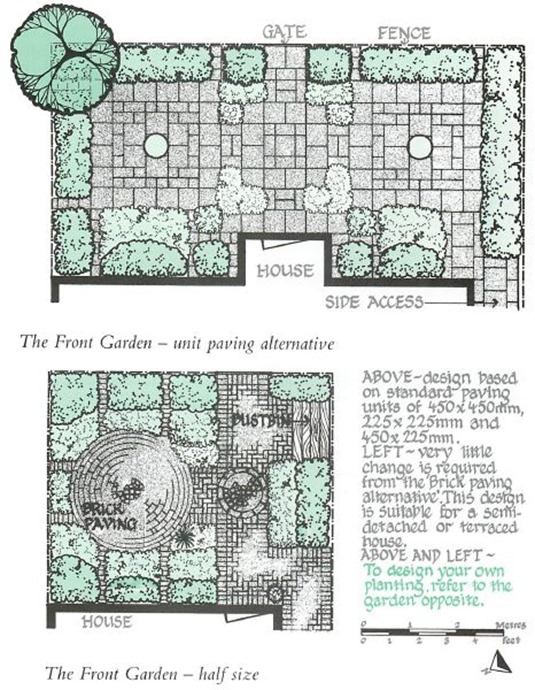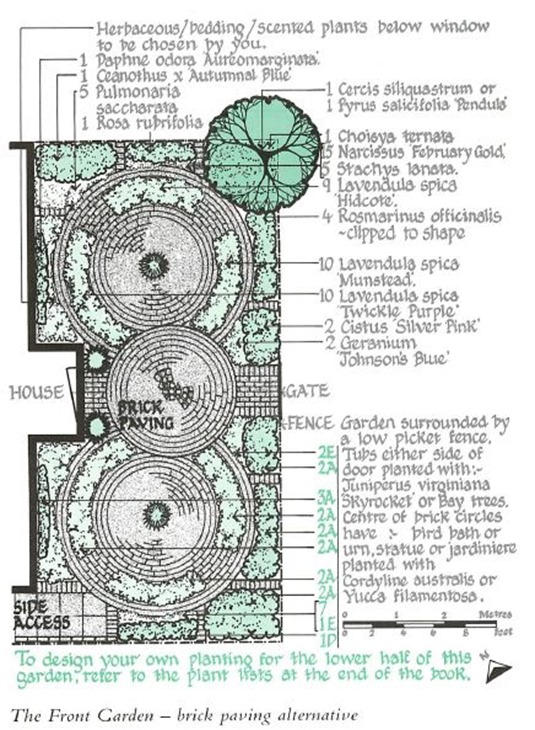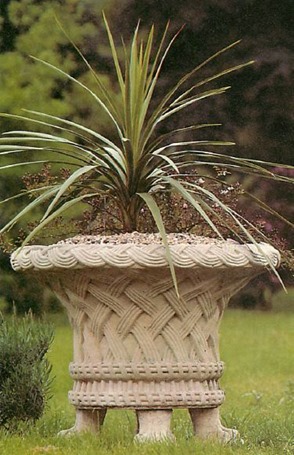





(Bright pink, purple and strong colours)
A front garden often appears to be a statement of what the owners would like the outside world to think of them. And indeed the appearance at the front of the house does make passers-by curious about the rear garden. If it is attractive, they will imagine that the back is better, even if it happens to be a jungle.
Very sociable gardeners may enjoy being exposed to the world at large as they cut back the flowering shrubs but, for those who don’t, it’s worth considering investing in low maintenance’ in the area in the front of your house. If you want to be seen outside your front door in your shirt sleeves or pinny with your rear to the sky, on your hands and knees pulling out the weeds as the neighbours pass you by, fine. But, if not, an attractive front garden that is not time-consuming is highly desirable.
Apart from its competitive aspect an attractive front garden also greatly enhances the visual appeal – and the value – of the property. When you are trying to sell a house, the first impression is obviously very important.
The design offers two alternatives, both based on the same principle, either two large squares and one smaller square in the middle, or two large circles with a small one between; each version is in a completely different price range. (A third alternative could be a simple paved area on each side of the path with a large jardiniere in the middle planted with a dramatic plant such as cordyline or a clipped bay. Very severe and smart.)
 And as many front gardens of semi-detached or terraced houses are half the size of the main design, a smaller alternative has also been drawn up. Very little change is required, only the detail in the runs of brick which will now have to splay out from the path to the main circle; also the runs of brick on the outer part of the circle will no longer encroach into the brickwork of the path.
And as many front gardens of semi-detached or terraced houses are half the size of the main design, a smaller alternative has also been drawn up. Very little change is required, only the detail in the runs of brick which will now have to splay out from the path to the main circle; also the runs of brick on the outer part of the circle will no longer encroach into the brickwork of the path.
As you come through the front gate which has a low picket fence on either side, you are presented with two large circles of brick with plants growing in between and a sundial, bird bath or plant featured in the centre of each circle.
 Round the perimeter of the garden, the planting areas are broken up with runs of brick, so the plants can be contained, and don’t grow into each other and get out of hand. The advantage of this is that only the plant or shrub fills the area between the bricks, and bricks alone occupy the space the weeds would otherwise try to dominate.
Round the perimeter of the garden, the planting areas are broken up with runs of brick, so the plants can be contained, and don’t grow into each other and get out of hand. The advantage of this is that only the plant or shrub fills the area between the bricks, and bricks alone occupy the space the weeds would otherwise try to dominate.
Around the two main circles, low perennial plants such as thyme, camomile and campanula break up and soften the area, while at the same time highlighting and drawing the eye to the circles of lavender or geraniums with the bird bath, plant, jardiniere, urn or statue chosen for the centre.
The path going up to the front door has a small circle of brick in the middle, an elegant luxury and one of the features that makes the design so special. Instead of the path going in a straight line to the house, you walk through a pattern of ever-decreasing brick circles until you reach the front step.
Should you decide to use brick rather than paving slabs, you will not be disappointed. Brick paving is to my mind one of the most beautiful paving surfaces. Providing you choose a suitable brick, it is long lasting and mellows superbly. On the other hand, brick will be more expensive than paving slabs, and should you be considering laying the bricks yourself, you should bear in mind that the preparation and the laying of bricks is hard work.
In Bangladesh bricks were used a great deal for roads and there are many well-worn herring-bone brick roads, some of which were laid many years before the British left in 1949. Driving over them in a rickshaw is one thing, but the pure delight of their smooth, rounded surface under bare feet is never to be forgotten. Yes, brick is beautiful. It has so much texture and warmth and, if it is within your budget, it is a wonderful addition to any property. Frost-proof, non-slip brick and not engineering bricks should be chosen.
The alternative paved version is not as unusual or pleasing as the brick but the advantage is that it is easy to lay yourself. You lay standard paving units of 18 in x 18 in (450 x 450 mm), 9 in x 9 in (225 x 225 mm) or 18 in x 9 in (450 x 225 mm) on to a flat bed of sand, or, for true low maintenance, it is more satisfactory to lay them on a bed of concrete. With sand, the paving can often become uneven and slippery after heavy rains because the slabs retain the moisture that seeps up from the sand below, and also there is the danger that weeds will grow in the sand between the slabs.
The procedure for laying slabs is reasonably straightforward. Level the space, then:
1. Check the surface is even with string and a spirit level, with a fall to take the water away from the house.
2. Spread sand or concrete over the whole area except areas required for planting, and again check the level.
3. Lay the standard paving slabs, leaving the squares you wish to fill with plants without either concrete or sand in them, ready for earth and compost for planting.
It’s important to remember when putting sand beneath the slabs that it should be under the whole slab and not just under the corners, otherwise when the temperature beneath the slab changes it will crack. The paving slabs will stop the more vigorous shrubs and plants from spreading too much.
Fink, purple and white colour scheme
T = Trouble free
T Cercis siliquastrum (Judas tree). Spring flowering purple-pink pea-like flowers. An ideal tree for this corner but it is not suitable for cold or clay gardens. It likes full sun so do not plant it if the garden is north-facing. Grows to 15-20ft (4.5-6 m). Bright green rounded leaves. An attractive ornamental tree with flowers growing directly off even quite old branches.
Or
Pyrus Salicifolia ‘Fendula’ (Willow-leaved pear) Dome-shaped weeping branches make this delightful ornamental tree an attractive feature. Masses of tiny silvery green leaves and cream flowers in spring. Height’8- 12ft (2.5-3.5m), spread 6-8ft (1.8-2.5m).
To use for the focal point in the centre of each circle or square there is the choice of:
T Rose Albertine (Rambler). Weeping standard. With its Strong fragrance and coppery pink flowers developing from salmon red buds it is a popular and pleasing standard rose. A spectacular centrepiece when in flower. It has glossy green leaves and flowers freely in June and July. Sunny position.
Or
T Bay tree (in tub). Planted in a tub or in the ground this tree dipped into a formal pompom shape is another elegant alternative for the centrepiece. The dark evergreen leaves are trouble-free and make a stylish feature. Not hardy in very cold areas. Tolerates shade or sun. Bay trees in tubs should be treated with systemic spray (to prevent disease) every few years.
In an urn the choice of:
T Yucca filamentosa Hardy stemless evergreen shrub. Good in poor conditions. Attractive long spiky erect leaves with wispy filaments peeling off the edges. Striking centrepiece. Ivory coloured, bell-shaped flowers in erect panicles 3ft-6ft 6 in (90 cm — 2 m) tall in July to August.
 T Cordyline australis With its straight, long, spiky green leaves, it also makes an elegant centrepiece for any urn or focal point but it is vulnerable to frost in winter and is best tied up with string to protect its ‘heart’ in November.
T Cordyline australis With its straight, long, spiky green leaves, it also makes an elegant centrepiece for any urn or focal point but it is vulnerable to frost in winter and is best tied up with string to protect its ‘heart’ in November.
Alternatively, the centrepiece could be a bird bath, sundial or sculpture (an interesting piece of wood or stone).
T Lavender Hardy evergreen shrub. In the summer this will make a stunning display of purple scented flowers round the centrepiece. Height 1-2ft (30- 60cm). Spread 18in-2ft (45-60cm).
Lavandula spica ‘Hidcote’ flowers July to September
Lavandula spica ‘Munstead’ blue flowers July to September
Lavandula spica ‘Twickle Purple’ flowers July to September. Long spikes. Prefers sunny position.
Or
Geranium pratense ‘Johnson’s Blue’ Hardy herbaceous perennial — but not the same as a pot plant geranium (Pelargonium) that grows in window boxes. Height 12 in (30 cm). Delicate blue flowers all summer long, prettily divided leaves. Excellent summer ground cover.
Other small plants to go round the side or between the paving slabs are camomile, thyme, campanula and vincas.
T Cistus ‘Silver Pink’ Height and spread 2—3ft (60-90 cm). Grey/green leaves above and grey beneath. Silver/pink flowers in June and July. Fairly hardy evergreen. Sun-loving.
Pulmonaria saccharata Hardy herbaceous perennial. Its unusual foliage makes it a good accent plant. Large flat green leaves with silver grey blotches. Pink flowers turning to blue in March and April. Height and spread 12 in (30 cm).
Rosmarinus officinalis Rosemary to form part of the hedge along the front fence line. Hardy evergreen shrub. Tiny silver/grey aromatic leaves. Small purple flowers March to April and then on and off until September. Sun-loving.
T Choisya ternata (Mexican orange blossom). Dark shiny aromatic evergreen leaves and clusters of white-flowers spring and autumn. Height 10-20ft (3-6m) (to grow along the fence). Shade and sun-loving. Most useful and undemanding shrub.
T Rosa rubrifolia Perfect choice to create a boundary on each side of the garden. It is undemanding, grows to 7 by 5ft (just over 2 m by 1.5m) and has unusual coppery mauve leaves with a grey tinge, light pink flowers in summer and attractive hips in autumn but it is its foliage that makes this a special plant. The thorns are small and not very troublesome. Sun and shade tolerant. Seeds itself.
T Stachys lanata (Lambs’ tongues) Herbaceous perennial. Soft furry long slim grey/silver leaves, woolly blue flower spikes June and July. Grows to 1 ft (30 cm), spread 2ft (60 cm) or more. Good summer ground cover.
Ceanothus ‘Autumnal Blue’ A lovely vigorous hardy evergreen shrub. Height 8-10ft (2.5—3m). Spread 6-10 ft (1.8- 3 m). Glossy large green leaves and delightful haze of blue flowers from July to September/October. Sun-loving.
Daphne odora ‘Aureomarginata’ Fragrant evergreen shrub. Grows to Aft (1.2m). Will easily follow the line under the window. Green leaf with creamy white variegation. Powerfully scented rose pink flowers from January or February through to April. Prefers shade.
Below the window there is room for some summer bedding such as night-scented stocks and Nicotiana (tobacco plant).
In tubs on either side of the front door
Juniperus virginiana ‘Sky Rocket’ (Pencil cedar). Slow-growing evergreen conifer. Will only grow to 8- 10ft (2.5-3 m) in a tub. Pale grey foliage and very slim and upright growth. Or
Bay Tree (see above).
Muscari ‘Heavenly Blue’ (Grape hyacinth) can be planted round the edge of the tub. Deep blue flowers appear in April/May. Height 8- 10ft (2.5-3 m) and Ivy (variegated) or Vincas or Fuchsia ‘Lady Thumb’, a hardy shrub which may be cut by cold weather. Delightful pink flowers in July. Light green leaves, height about 2ft (60 cm).
Copyright © www.100flowers.win Botanic Garden All Rights Reserved